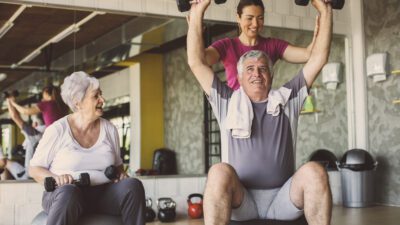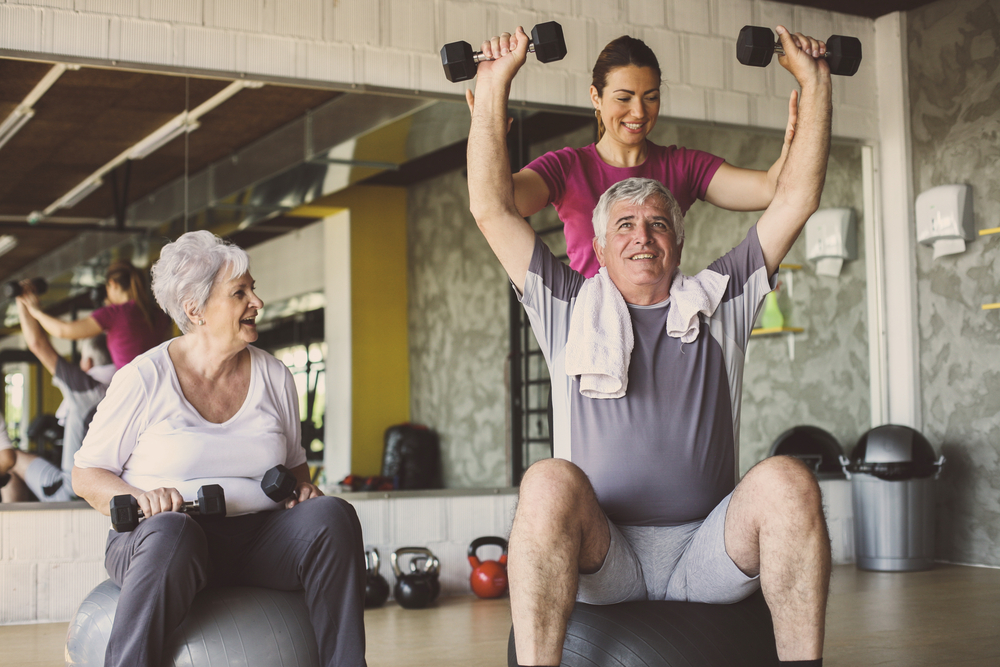



With the NHS advising daily physical activity for older adults, the increasing demand for personal trainers with experience training older adults is not surprising. This is because older adults above 65 years have different training needs than the average young client. Ageing involves decreasing muscle mass, reduced flexibility, balance issues, and cognitive changes, requiring a more intricate personal training approach.
Are you a personal trainer thinking of diversifying your clientele?
If yes, keep reading.
This article will provide concise information on the needs of your prospective older clientele and tips you can use to ensure that they get the best care.
So, let’s get right to it.
Even though ageing is a natural phenomenon, it comes with some physical and cognitive changes, like slower metabolism, reduced muscle mass, decreased balance, health risks, etc. This is why you cannot expect an older client to have the same workout plan as your young clients – you must tailor it to meet their needs. For example, if your client is at risk of always falling, you can focus on balance and flexibility exercises to reduce the risk. Also, if your client has some problems with maintaining focus, you can customize the structure of the workouts with that in mind.
>> Learn more: 13 jobs for former teachers
It is a common misconception that older clients are usually weaker, especially in the fitness industry, but this is not always true. Although they are more susceptible to health issues and injuries that can limit their strength, training them according to their individual assessment results and needs is a better approach than assuming they are all weak. Below are a few more tips you will need when training older clients.
You need to have the right qualifications before you can start training older adults. This is because personal training courses enable you to understand the anatomy and physiology of the human body, as well as functional training.
You can even go as far as getting a level 3 personal trainer course that includes exercise for older adults. This way, your prospective clients will ensure you have the skills and qualifications needed to train them.
Comprehensive assessment before starting any training is vital, especially for older clients, as you need to take note of their fitness level, goals, exercise experience and medical history. You can do fitness tests to evaluate your client’s present fitness level. Additionally, you can go as far as ensuring they get consent from their doctor before starting the workout program. This way, you can determine potential health risks and create a safe, efficient workout plan.
You need to tailor your workout plans to your clients, as no two people have the same fitness needs and medical background. For example, an older active client can do a wider range of workouts than an older client who has never set foot in a gym. Also, if your client has a history of health problems like high blood pressure, heart disease, stroke, and others, you need to modify their workouts around their health issues.
Sometimes, your older clients may be reluctant to try new workouts or movements. Other times, they may just find it hard to complete their workouts. These are a few situations where you need to guide them and motivate them.
You should praise them when they complete any fitness hurdle, as this boosts their confidence and motivates them to do more.
You must recognise that the milestones for your older clients will differ greatly from your younger clients. So, you need to set realistic goals with your clients and celebrate any achievements they make – no matter how small.
Also, because motivating them can be a difficult task sometimes, you need patience if you want to do this job well.
You must always remind them of their fitness goals and guide them towards achieving them. For example, your client with poor mobility and flexibility might need more motivation to complete flexibility and balance exercises. The same goes for a client with reduced bone density and muscle mass requiring more guidance for strength and endurance exercises.
You must remember that every client requires something different from you regarding motivation and guidance – so work accordingly.
Since age decreases bone density and muscle mass, you can integrate strength training exercises to help your older clients preserve and develop them.
Some strength exercises include free weights, resistant bands, and bodyweight workouts. You can aim to do these exercises at least twice weekly to target the primary muscle groups.
Even though sprints are not advisable for older adults, cardio exercises strengthen their heart and lungs. While some older adults can briskly walk or jog on the treadmill, others may not be able to because of balance issues. So, it is best to accommodate their physical limitations when incorporating cardio exercises. Some alternatives include walking outside or using stationary bikes.
As a personal trainer, you need to be aware that range of motion, balance, and flexibility reduce as a person gets older. This means that older and younger adults cannot do the same amount of physical activity –because, for the former, their movements become more limited.
These restrictions are why you should ensure your older clients keep a low range of motion throughout their workout. By doing this, you can define their base fitness level and be able to tailor workouts around it.
Additionally, you must keep an eye on their form, mobility, and exhaustion levels at all times to avoid any accidents.
Communicating clearly and constantly is essential in personal training. Even though it helps you to give clear and concise instructions about the exercises, good communication is much more than that. It requires active listening, empathy, and understanding.
Your clients need to feel comfortable enough to inform you if they are having any issues with the workouts or if they are ready for more intensity. They need to trust that you are on their side and will provide the support they need.
The way you teach is vital, which is why you need to use visual demonstrations, break down complex movements into simpler ones, and adjust the pace of the workouts for every client.
Injury prevention is very important, especially to a personal trainer for older adults. Lack of warm-ups and cool-downs are a few major reasons why injuries happen during workouts. Warming-up exercises prepare your joints and muscles for exercises while increasing the range of motion, and they include low-intensity movements and dynamic stretching.
Cool-down exercises, on the other hand, help to relax the body and slow down the heart to a normal pace after workouts, and they include static stretching like chest stretch and corpse pose.
Older clients require more workouts than focus on improving their mobility, flexibility, and balance, as this will improve their daily lives extensively.
They do not require high-intensity workouts like younger adults, as they need training to make it easy to carry out daily functions and avoid accidents. These regular stretching and flexibility workouts target major muscle groups, like hips, shoulders, and lower back, which are predisposed to tightness with age.
Alongside balance and mobility, posture and movement decrease with age, and a majorly responsible muscle group is the gluteal muscle group. This means you should incorporate glute exercises into your client’s workout plan, especially if they have movement and postural issues. Some exercises you can add to activate the hip extensor muscles include glute bridge, hip circles, and hip abduction.
Unilateral exercises, like single-arm exercises, lunges, and step-ups, are a good way to improve balance and flexibility as they build strength on both sides of the body. They also help to strengthen the core, which aids movement and stability.
You need to track the progress of your clients to enable you to increase the intensity and duration of their exercises as their fitness level increases. This progress tracking also allows you to know whether or not your client is making headway or if they need modified workouts. Plus, you can integrate new exercises into their workout plan to keep them engaged and stimulate the various muscle groups.
You should avoid extreme exercises, especially for beginner clients. Some extreme exercises include barbell workouts like deadlifts and bent-over rows, kettlebell swings, burpees, sprints, box jumps, and high-intensity interval training. Instead of these exercises, focus on mobility and flexibility.
While younger clients may not mind rush hour at the gym, older adults may not appreciate the crowding. This is why you must ensure that the location you choose for your training is ideal for a senior. Avoid gyms that have loud music, as your clients may not appreciate it. But, you should discuss with your clients and factor their dislikes into your overall decision.
As a personal trainer for older adults, you have a very important role in improving the lives of senior citizens. However, you must be patient, flexible, and respectful in all your dealings with your clients, as they are more set in their ways than younger clients.
Additionally, you must endeavour not to assume that all older adults are the same or weak.